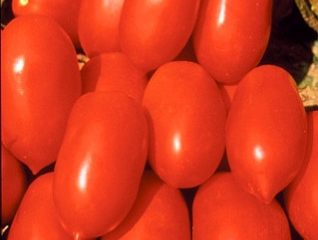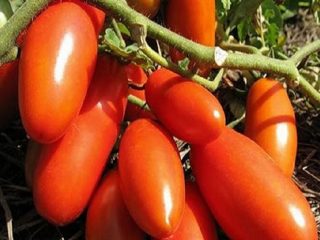Content
Breeders around the world are constantly working to create new varieties of tomatoes. One of the successful fruits of titanic labor is the Olga tomato. It is suitable for greenhouse cultivation, in open ground, on a personal plot and on an industrial scale.
History of selection
The history of the appearance of the Olga tomato hybrid began in the early 90s. Specialists from the Hazera company (Holland) worked on the creation of the variety.

Already in 1997, the variety was registered and approved for use in Russia
Description of the tomato variety Olga F1
The Olga tomato bush is strong and determinate, that is, after the appearance of the inflorescence at the top, it stops growing in height, but the side shoots begin to develop rapidly, where the fruits are formed.
Flower brushes are formed after the sixth leaf, then after every third. The foliage is medium, the color is emerald. Does not require constant pinching. On each bush, no more than 15 brushes are formed, with 5-7 ovaries.
Standard tomatoes.Does not require mandatory tying. The height of the Olga tomato is limited to 90-100 cm. In greenhouses it can stretch more - up to 1.25 m.
Fruits with excellent presentation, one might say one to one. They are well transported and do not crack, even if there is high humidity. If storage rules are followed, they do not deteriorate and retain their presentation for a long time.
Tomato inflorescences do not fall off when the air temperature drops to +8 OC. For the ovary to begin to develop, you will have to wait until the thermometer rises to +14-16 OWITH.

Before planting tomato seeds, the soil is treated with a weak and hot solution of potassium permanganate.
Characteristics of tomato Olga F1
The shape of the tomatoes is round, with pronounced ribbing. Thick and smooth skin, red.
The pulp of tomatoes is dense, fleshy and at the same time juicy. There are few seed boxes - no more than four. Average number of seeds.
The taste of the tomato is excellent. But you need to grow tomatoes in a well-lit place.
The average weight of tomatoes is 115-120 g, but if carefully cared for (fertilized and watered), it increases to 170-175 g.
Maturation period
The variety is considered early ripening. Olga tomatoes are formed and ripened within 105 days from the moment of sowing the material. Tomato ripening is consistent.
Tomato productivity Olga
The Olga tomato variety is high-yielding. From 1 square meter they harvest up to 15.5 kg. In a greenhouse this figure is much higher - up to 25-27 kg.
Resistance to diseases and pests
Breeders have done everything to ensure that tomatoes have excellent immunity at the genetic level. Olga F1 fruits are not afraid of tobacco mosaic, late blight, verticillium wilt, fusarium wilt and even neck rot. It tolerates nematode attacks quite well.
In what regions is it grown?
Tomatoes of the Olga variety can be grown throughout Russia, despite the fact that they are included in the State Register for the North Caucasus region. In cold regions, it is recommended to plant them in greenhouses even without heating. In the southern zone - in open ground.
How to use
Olga variety tomatoes are suitable for making salads. But most often they are used for whole-fruit canning due to their standard compact size and low weight. Larger fruits are suitable for making paste and juice.
Advantages and disadvantages
In addition to good immunity and taste, Olga tomatoes have many other advantages.

Sugar content in tomatoes is 2.5-3.5%
Pros:
- compact plant size;
- stress resistance;
- easily tolerates return of coolness, heat and drought;
- does not require special growing and care conditions;
- stepsons are formed in moderate quantities;
- almost identical fruit size;
- universal variety;
- tolerates transportation and storage well, tomatoes do not lose their presentation for a long time;
- Suitable for growing in open and closed ground.
Minuses:
- With a lack of sun, the amount of sugar is reduced and sourness appears in the taste.
Features of cultivation
To get the harvest as early as possible, it is recommended to propagate tomatoes by seedlings. It is recommended to sow seeds in late March or early April. You can use purchased soil or prepare it yourself using the following components:
- peat – 2 parts;
- rotted wood - 2 parts;
- greenhouse soil – 4 parts.
It is allowed to add eggshells or perlite, then the soil will be more loose. The soil mixture is prepared at least 24 hours before sowing. Picking is carried out after the appearance of 2-3 true leaves on the young plant.

The yield of marketable fruits is at the level of 96-100%
Before moving the bushes to a permanent place, they are fertilized twice. It is recommended to add a urea solution to the first, and a mixture of superphosphate and potassium soda, preferably mixed with wood ash, to the second.
Seedlings need to be hardened by taking them out onto the balcony every day for 30 minutes, gradually increasing the period.
At home, it is not recommended to grow seedlings for longer than 60 days. If the plants overgrow, the harvest will be late. To prevent overgrowth, it is recommended to carry out a second pick 21 days after the first.
Planting pattern in a permanent place - 50x45 cm. Per 1 sq. m there should not be more than six plants.
Olga tomatoes should be watered as the soil dries, but at least once every 6-7 days. If the weather is dry, then water more often - once every 2-3 days.

Loosening the soil around plants is mandatory while removing weeds
Do not neglect feeding tomatoes, otherwise the fruits will be smaller in size than stated by the breeder. Fertilizer application rules:
- in a permanent place, fertilizing is applied for the first time two weeks after planting, this can be a yeast solution;
- after another 14 days, add an ash solution;
- after 14 days, fertilize with boric acid and iodine solution.
After each watering, do not forget to mulch the soil. Any organic materials can be used.

Tomatoes of the Olga variety are not afraid of low light, but with a long absence of sun, the total amount of harvest decreases
Pest and disease control
If the Olga tomato is exposed to unfavorable conditions for a long time, then there is a risk of infection with cladosporiosis (brown spot). Recognizing the problem in the early stages is problematic. The disease begins from the bottom of the bush. Chlorotic spots appear, which over time acquire a brownish-brownish tint. Spores are visible on the spots. The pathology gradually spreads to the upper part of the plant. At the first stages, the problem is confused with powdery mildew, so the measures taken do not have the desired effect.

After the appearance of brown spot, not only the soil, but also the entire greenhouse and supports for the garter must be treated with fungicides
High humidity and temperature are favorable for the pathogen. Under such conditions, spores do not die for up to 12 months. To avoid problems, it is important to carry out preventive measures in the greenhouse:
- maintain optimal temperature;
- avoid sudden changes in air temperature;
- ventilate the greenhouse;
- remove all affected parts of the bushes;
- disinfect the soil before sowing and after harvesting.
Important! If cladosporiosis has already manifested itself, then use fungicides based on benzimidazole or dichlofluanid. In open ground, the pathogen appears less frequently.
Conclusion
Tomato Olga is a hybrid variety with very tasty fruits of the same size. The species is high-yielding, undemanding in care, with good immunity and keeping quality.Suitable for fresh consumption, for any preparation and cultivation on an industrial scale.
Reviews from gardeners about the tomato variety Olga








